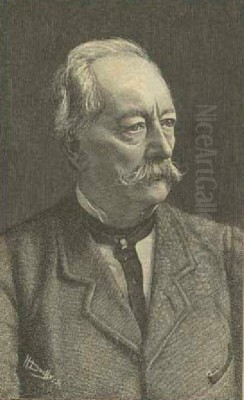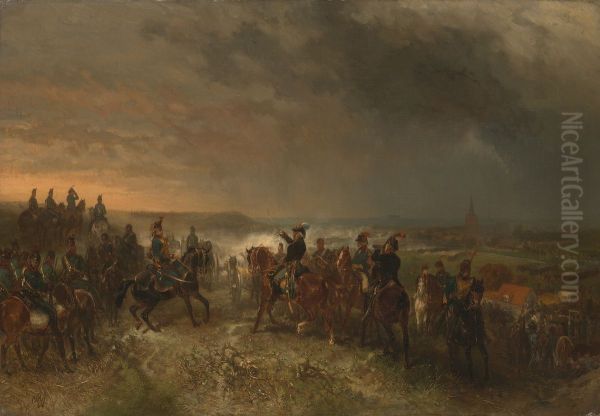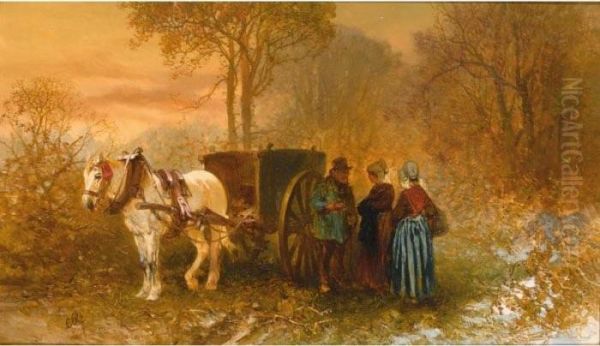
Charles Rochussen stands as a significant figure in 19th-century Dutch art, a versatile artist whose career spanned painting, illustration, and printmaking. Born in Kralingen, Rotterdam, on August 18, 1814, and passing away in the same city on September 22, 1894, Rochussen's life and work bridged the gap between the established traditions of Romanticism and the burgeoning movements of Realism and Impressionism. His oeuvre provides a rich tapestry of Dutch history, contemporary life, and the evolving artistic landscape of his time.
Early Life and Artistic Inclinations
Charles Rochussen was the second son of Hendrik Rochussen, a prosperous merchant and an enthusiastic amateur painter. This familial environment likely nurtured Charles's nascent artistic talents. From a young age, he demonstrated a keen eye for detail and a passion for drawing. Between 1831 and 1834, while still a teenager, he produced a series of delicate watercolors depicting birds, showcasing an early proficiency and an interest in the natural world.
Despite this early promise, Rochussen initially pursued a career in commerce, following a more conventional path for a young man of his social standing. However, the call of art proved too strong. At the age of twenty-two, around 1836, he made the decisive shift to dedicate his life entirely to painting. This decision marked the beginning of a long and prolific artistic journey.
Formal Training and Influences
To hone his skills, Rochussen sought formal instruction. In 1837, he enrolled at the prestigious Academy of Art in The Hague (Haagsche Teeken-Academie). There, he studied under the tutelage of notable artists of the day, including Wijnand Nuijen and Anthonie Waldorp. Nuijen, though his career was tragically short, was a significant figure in Dutch Romantic landscape painting, known for his dramatic and picturesque scenes. Waldorp, on the other hand, was recognized for his cityscapes and marine paintings, often imbued with a calm, meticulous realism.

Under their guidance, Rochussen initially focused on landscapes, seascapes, and depictions of rural life. His early works from this period reflect the prevailing Romantic sensibilities, characterized by an appreciation for nature's beauty and often a nostalgic or idealized portrayal of peasant life and historical settings. He absorbed the techniques and thematic concerns of his teachers, yet even in these formative years, a distinctive personal style began to emerge.
A Prolific Painter of History and National Identity
One of Charles Rochussen's most significant contributions to Dutch art lies in his historical paintings. He possessed a deep interest in the history of the Netherlands and excelled at bringing pivotal moments and figures from the nation's past to life on canvas. These works were not merely illustrative; they were imbued with a sense of drama, patriotism, and a keen understanding of historical detail in costume and setting.
Among his celebrated historical pieces is "The Coronation of William I in Hengelo" (1864), a grand depiction of a key moment in the establishment of the modern Dutch monarchy. Another notable work, "Slag bij Castricum" (Battle of Castricum, 1864), vividly portrays a significant military engagement. His painting "Melis Stoke bij graf Floris V" (Melis Stoke at the grave of Floris V, 1864) captures a poignant moment of historical reflection, referencing the medieval Count of Holland. Furthermore, his "Coronation of William and Mary" depicted the joint monarchs who also ruled England, Scotland, and Ireland, highlighting a significant period in Dutch and European history.
These historical narratives resonated deeply with the 19th-century Dutch public, a period when national identity and historical consciousness were being actively cultivated. Rochussen's ability to render these scenes with both accuracy and artistic flair made him a popular and respected historical painter. His works often found their way into public collections and were admired for their educational as well as aesthetic value.
Landscapes and Genre Scenes: Capturing Dutch Life
While historical subjects formed a core part of his output, Rochussen was also an adept painter of landscapes and genre scenes. He possessed a remarkable ability to capture the unique atmosphere of the Dutch countryside, its waterways, and its changing seasons. His "Winter street scene" (1856) is a fine example, evoking the crisp air and muted light of a Dutch winter, with figures and activities that bring the scene to life.

Another work, "Travellers by a horse and cart in a wooded landscape," demonstrates his skill in composing picturesque scenes that combine natural beauty with human presence. These paintings often featured ordinary people engaged in everyday activities, reflecting a growing interest in Realism that was beginning to permeate European art. His landscapes were not always grand or dramatic; often, they celebrated the quiet charm and specific character of the Dutch environment.
Rochussen's approach to landscape painting evolved over his career. While his early works were more aligned with Romantic conventions, his later landscapes showed a looser brushwork and a greater concern for capturing the fleeting effects of light and atmosphere, hinting at the influence of the burgeoning Impressionist movement.
The Allure of the Exotic: Colonial Representations
The 19th century was an era of colonial expansion for many European powers, including the Netherlands. This global reach brought new subjects and themes into European art. Rochussen contributed to this genre with works related to the Dutch colonies. His hand-painted piece, "Indigenous Surinamese," created for the International Colonial and Export Exhibition held in Amsterdam in 1883, is particularly noteworthy.
This exhibition aimed to showcase the products, cultures, and peoples of the Dutch colonies, particularly from the Dutch East Indies (now Indonesia) and Suriname. Rochussen's work depicted a Surinamese village, offering a European audience a glimpse into the lives of the indigenous people of this South American colony. Such representations, while often viewed through a colonial lens, are important historical documents that reflect the complex relationship between the Netherlands and its overseas territories. Rochussen's involvement in such projects underscores his versatility and his engagement with contemporary cultural phenomena.
A Master of Illustration and Printmaking
Beyond his achievements as a painter, Charles Rochussen was a highly accomplished and sought-after illustrator and printmaker. He possessed a remarkable talent for visual storytelling, which made him an ideal collaborator for authors and publishers. His illustrations graced the pages of numerous books, bringing literary narratives to vivid life.
He provided illustrations for Dutch editions of internationally renowned works, such as Harriet Beecher Stowe's "Uncle Tom's Cabin," a book that had a profound impact on public opinion regarding slavery. He also illustrated adventure stories like "Dwars door Africa" (Straight Through Africa), catering to the 19th-century fascination with exploration and distant lands. His work on "De spoorjekenaar" (The Railway Man) reflects the era's technological advancements and their impact on society.
Rochussen's skill as a printmaker, particularly in etching and lithography, allowed his work to reach a wider audience. His prints often depicted similar themes to his paintings – historical events, genre scenes, and landscapes – but with the distinct characteristics and expressive potential of the print medium. His "Battle between knights and foot soldiers" (1824, though the date seems early for his mature work and might refer to an early attempt or a later print of an earlier drawing) showcases his ability to handle complex compositions and dynamic action even in monochrome.
In 1841, he created a significant series of fourteen stage designs for performances of plays by Joost van den Vondel, the great Dutch poet and playwright. These designs became influential references for theatrical productions throughout the latter half of the 19th century, demonstrating his impact on the visual culture of the stage.
Artistic Style and Evolution: Bridging Traditions
Charles Rochussen's artistic style is fascinating for its evolutionary nature. He began his career firmly rooted in the Dutch Romantic tradition, influenced by artists like his teacher Wijnand Nuijen. However, as his career progressed, particularly from the 1840s onwards, his style became freer and more experimental. His brushwork loosened, his palette sometimes brightened, and his approach to composition became more dynamic.
He is often seen as an artist who bridged the gap between the more traditional, meticulous styles of the early 19th century and the innovative approaches of the Hague School and early Impressionism. While not strictly an Impressionist himself, his later works exhibit a concern for capturing momentary effects of light and atmosphere, a more direct observation of reality, and a less polished finish than was typical of academic painting. This "impressionistic touch" or "suggestive power" was noted by contemporary critics.
His connection to the Hague School, a movement of Dutch realist painters active from roughly 1860 to 1890, is also significant. Artists of the Hague School, such as Jozef Israëls, Anton Mauve, Hendrik Willem Mesdag, and Willem Roelofs, favored realistic depictions of Dutch landscapes, peasant life, and coastal scenes, often characterized by muted palettes and an emphasis on atmosphere. Rochussen shared many of these thematic concerns and his evolving style paralleled some of the developments seen in the Hague School, even if he maintained his own distinct artistic identity.
Rochussen as Educator and Mentor
Charles Rochussen was not only a prolific creator but also a dedicated educator. He held a teaching position at the Hague Art Academy, where he had once been a student. In this role, he influenced a new generation of artists, passing on his knowledge and experience.
One notable instance of his mentorship involves George Hendrik Breitner, who would later become a leading figure of Amsterdam Impressionism. Rochussen recognized Breitner's talent and advised him to pursue further studies in The Hague. This guidance played a role in shaping Breitner's early career. Rochussen's willingness to support and guide younger artists highlights his commitment to the Dutch artistic community.
Collaborations and Contemporaries: A Vibrant Artistic Milieu
The 19th-century Dutch art world was a dynamic environment, and Rochussen was an active participant. He maintained friendships and professional relationships with many of his contemporaries. His lifelong friendship with Johan Barthold Jongkind is particularly noteworthy. Jongkind, a Dutch painter often considered a precursor to Impressionism, shared with Rochussen an interest in exploring new aesthetic ideas in landscape painting. They reportedly spent time together sketching outdoors and discussing their artistic philosophies.
Rochussen also collaborated directly with other artists. His work with Charles Leickert on "Dutch Winter Landscape" (1845) is a documented example. Leickert, known for his atmospheric winter scenes and cityscapes, was a contemporary whose style complemented Rochussen's. Such collaborations were not uncommon and often proved mutually beneficial. Leickert himself had studied under the great Romantic landscapist Andreas Schelfhout, whose influence was pervasive in Dutch landscape painting of the era.
Rochussen was part of a vibrant artistic circle that included figures like Samuel Verveer and his brother Salomon Verveer, both known for their genre scenes and cityscapes, often with Jewish themes in Samuel's case. Cornelis Springer, a master of meticulously detailed Dutch townscapes, was another prominent contemporary. The leading Romantic landscapist Barend Cornelis Koekkoek, though perhaps operating in a slightly different sphere of highly polished landscapes, was also a dominant figure during Rochussen's active years. Rochussen's interactions within this community, whether through formal associations like "Arti et Amicitiae" in Amsterdam or informal friendships, were crucial to the exchange of ideas and the development of Dutch art.
Exhibitions and Recognition
Throughout his career, Charles Rochussen regularly exhibited his work, gaining recognition and accolades. His participation in the 1883 Amsterdam Colonial Exhibition with "Indigenous Surinamese" has already been mentioned. He was also a frequent exhibitor at "Arti et Amicitiae" (Art and Friendship), a prominent Amsterdam-based artist society and exhibition venue. His involvement in their 1865 exhibition, for example, indicates his standing within the Dutch art establishment.
In 1860, his painting "Graaf Floris V op den dijk te Vroone" was shown at an exhibition organized by the Rotterdam Academy of Art and Technical Sciences. Such exhibitions were vital for artists to showcase their latest creations, secure commissions, and engage with critics and the public. Rochussen's consistent presence in these venues underscores his productivity and the sustained demand for his work. His art was acquired by important collectors and found its way into major Dutch museums, including the Amsterdam City Museum (Stedelijk Museum Amsterdam) and the Museum Boijmans Van Beuningen in his native Rotterdam.
Legacy and Enduring Appeal
Charles Rochussen passed away in 1894, leaving behind a substantial and diverse body of work. His legacy is multifaceted. As a historical painter, he contributed to the visual narrative of Dutch national identity. As a landscape and genre painter, he captured the essence of Dutch life and environment with sensitivity and evolving technique. As an illustrator, he brought literature to life for a wide audience and contributed to the visual culture of his time.
His position as a transitional figure, linking the Romanticism of the early 19th century with the emerging Realist and Impressionist tendencies of the later decades, makes him particularly interesting from an art historical perspective. He was an artist who adapted and evolved, responding to the changing artistic currents while maintaining his own distinctive voice.
Today, Charles Rochussen's works are held in numerous public and private collections, primarily in the Netherlands but also internationally. They continue to be appreciated for their technical skill, their narrative power, and the insight they offer into 19th-century Dutch art and society. He remains a testament to the richness and dynamism of a pivotal era in European art.
Conclusion: A Versatile Chronicler of His Time
Charles Rochussen was more than just a painter; he was a visual chronicler of his era. His dedication to Dutch history, his keen observation of contemporary life, his prolific work as an illustrator, and his engagement with new artistic trends mark him as a significant and versatile artist. From the grand historical canvases that stirred national pride to the intimate landscapes that captured the Dutch spirit, and from the detailed book illustrations that fired the imagination to his explorations of colonial subjects, Rochussen’s art offers a comprehensive view of the 19th-century Netherlands. His ability to navigate and contribute to the evolving artistic landscape, bridging older traditions with newer sensibilities, secures his place as an important figure in the history of Dutch art.